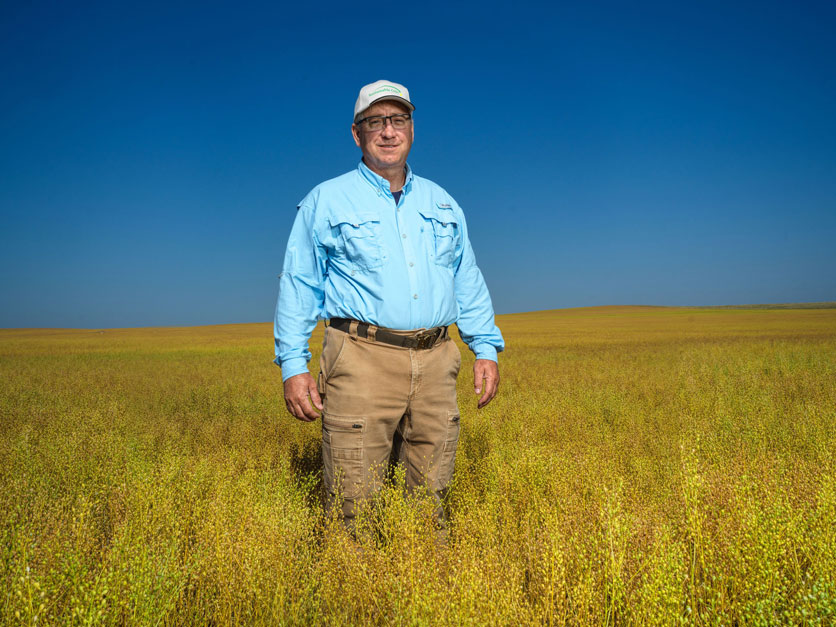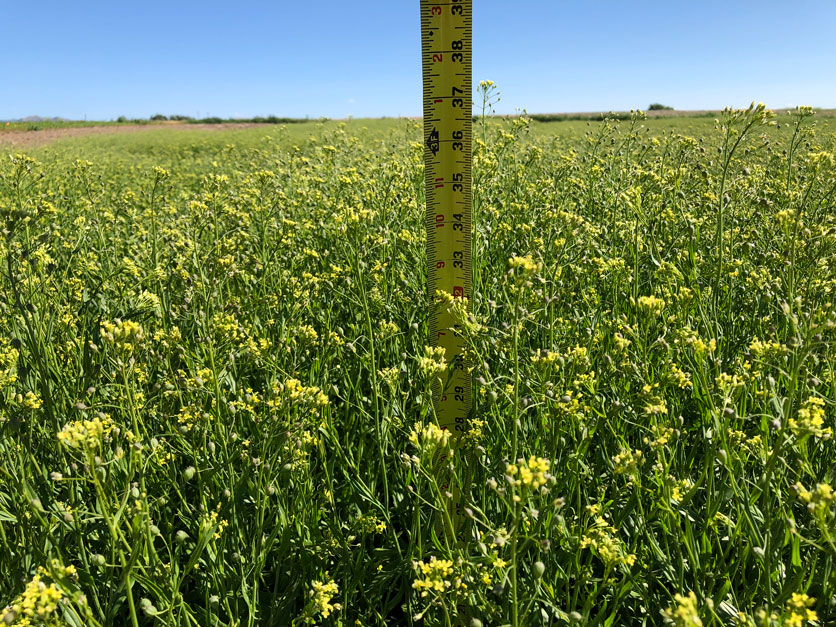A minor oilseed may be poised to take on a larger role as climate-smart policies emphasize low carbon fuels and the soil health benefits of cover crops. Camelina is seen by some as a cover crop that recoups a farmer’s investment because it can be harvested instead of plowed under. One current destination for camelina is a renewable diesel plant coming online in Bakersfield, California. But camelina fans say its future could also include bioplastics.
Scientists with USDA 's Agricultural Research Service have spent years amassing data to determine whether camelina could be a third crop to break up the standard Midwest corn-soybean rotation.
They’ve looked at how the camelina compares to ryegrass as a cover crop, whether growing camelina in a field hurts the major crop yields that follow and what the changes to nitrogen loss and soil health are when camelina is in the mix. Their goal is to help farmers and others see more clearly how to increase agricultural productivity while reducing harmful environmental effects.
John Kovar, a soil scientist with ARS in Ames, Iowa, says the plots with camelina have done pretty well. In 2019, the soybean field also planted with camelina “out-yielded the rest” of the plots. But camelina is no slam-dunk. Rob Malone, also with ARS in Ames, says the research team is paying close attention to what resources the camelina needs. He says one concern about relay cropping or double cropping—both terms used to describe a growing a cash crop in the season between two existing crops—is that the additional crop uses a little more water. Some years, he says, “that little bit is enough to cause some water stress” for the crop that follows.
For more in-depth coverage of cover crops, read our four-part series, "Cover crops: The potential, the pitfalls, and the policy options."
The camelina experiments are part of a bigger, six-year study comparing conventional, no-till and cover cropping systems. Kovar says although 2021 was the final year, the researchers haven’t finished amassing and analyzing the data, which is all part of a larger Mississippi River Basin-wide research project on nutrient loss in corn-growing systems.
But in the meantime, the private sector has also been pursuing camelina as a third crop, biofuels feedstock and a potential source for bioplastics.
 Mike Karst, president of Sustainable Oils.
Mike Karst, president of Sustainable Oils.
Sustainable Oils is a subsidiary of Global Clean Energy, a company that has recently converted the refinery in Bakersfield to a renewable diesel operation. Sustainable Oils has partnered with Cenex Harvest States (CHS) to encourage Montana farmers to plant camelina during the time when they otherwise would be fallowing land between crops.
Mike Karst, president of Sustainable Oils, says in Montana camelina can be planted in April and harvested in August so farmers can “come back in and plant winter wheat in behind us that same year and then have a winter wheat through the next winter season.”
He says that puts a crop on the ground when otherwise some farmers wouldn’t have anything growing. In Colorado and Kansas, though, Karst says camelina gets planted in November or December and harvested in early June.
“They can then come back in with a double crop of sorghum, for example, or a double crop of soybeans, particularly if they have irrigation water.” As a winter annual in that part of the country, Karst says camelina “gives [farmers] another full crop in a season when they had absolutely nothing growing there to begin with.”
Karst says the partnership with CHS connected Sustainable Oils with the elevator and rail lines necessary to get the camelina crop directly to Bakersfield. He knows that shipping camelina across the West comes with a carbon cost, but he says that’s been calculated all along the way as the project was developed. “Those trains are highly efficient because it's one pickup point and it's one delivery point,” he says.
And now, Sustainable Oils is building its own storage at the CHS elevator site to increase capacity as demand grows. Last year, Sustainable Oils had 15,000 acres in camelina in Montana, and Karst says he expects that figure to be “substantially higher” next year. Exxon Mobil has signed an agreement with Global Clean Energy to buy 5 million barrels of renewable diesel per year for five years.
Looking for the best, most comprehensive and balanced news source in agriculture? Our Agri-Pulse editors don't miss a beat! Sign up for a free month-long subscription by clicking here.
Karst says camelina has a low “carbon intensity” score compared to other plant feedstocks and because it’s grown when food crops aren’t in the fields, it can be produced on existing agricultural lands without diminishing food production.
Early researchers saw the promise of camelina decades ago. Oliver Peoples, currently the CEO of Yield 10 Bioscience, had his sights on bioplastics when he began work to transfer genetic information from microbes into plants so the plants could be used for PHA bioplastics. That early work got shelved until genetic engineering advanced in ways that make the process more plausible. By 2019, Peoples was able to plant the first seeds of his genetically engineered camelina for bioplastics. But the aspect of his work in camelina that has come to the marketplace first is as feedstock for biofuels.
 Oliver Peoples, CEO, Yield 10 Bioscience
Oliver Peoples, CEO, Yield 10 Bioscience
Peoples looks at the attention to cover crops and sees a flaw in the strategy to get farmers to keep living roots on the soil year-round. “Farmers literally have to be subsidized to get them to grow these types of crops,” he says, because the seeds costs money and the plants don’t generate any. But he says with the U.S. Energy Information Agency projecting renewable diesel production capacity could reach 5 billion gallons by 2024 and existing feedstock only capable of providing about 1 billion gallons, “we’ve got to find another 4 billion gallons of feedstock.”
He thinks camelina can help fill that gap while also offering “additional revenue for the grower.”
A challenge for the drive to engage farmers in more climate friendly practices is the tendency to expect a quick policy decision to be broadly applicable. Conversely, farmers know they need to see how something works in their region, with their soil and their weather, before committing. That has quelled enthusiasm for cover crops in certain areas, even as the Build Back Better bill pending in the Senate would offer farmers $25 an acre to plant them.
Oregon and Washington are launching their own low carbon fuel standards and other states, including Minnesota, are beginning to explore the prospect. So demand for renewable diesel could expand far beyond California fairly quickly. Karst says he’s already talking with people in disparate locations who might buy, store and even process camelina in the future.
Peoples says some of the major seed companies are interested in camelina and the technology tools his company has developed could be used to stack traits needed for it to thrive in other places or for different uses.
 It will be some time before farmers know how camelina measures up. (courtesy Yield 10 Bioscience)
It will be some time before farmers know how camelina measures up. (courtesy Yield 10 Bioscience)
But the Midwest research finds camelina on its own won’t give farmers a golden ticket for environmental quality. In the Corn Belt, the research focus was on improving water quality through nutrient retention. The corn-camelina-soybean system did not reduce nitrogen loss compared to conventional corn and soybeans and no-till plots. The rye cover crop between cash crops had the most impact on nitrogen loss, according to results through 2020. Even though the experimental design pitted four different cropping systems against each other, farmers ultimately don’t have to choose only isolated options. The ARS researchers conclude that “multiple complementary management practices may be the best path to navigate the tradeoffs.”
The growth in demand for camelina certainly will influence whether more farmers look into it, as will the calculation of whether taking on an unknown third crop offers enough potential income to offset the risk as compared to taking a government subsidy to plant a traditional cover crop.
But Peoples is confident camelina will take off, first for biofuels and eventually as a source for alternative plastics.
“We are seeing increasingly these tailwinds of grower interest,” he says, “but also government interest.”
Noah Wicks contributed to this report.
For more news, go to www.Agri-Pulse.com.

